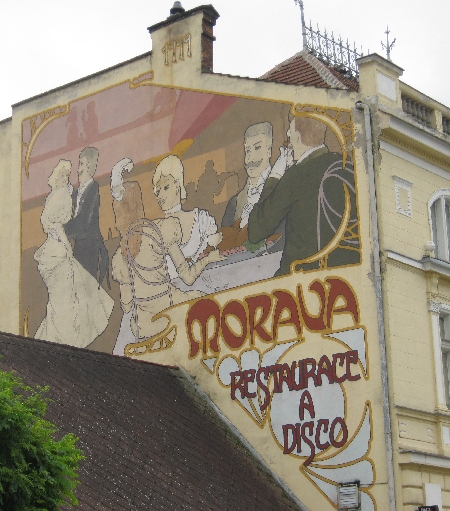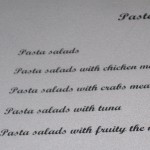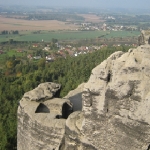
After the disappointment of the Wallachian Open-Air Museum being closed on Mondays, we left Rožnov pod Radhoštem and headed south, having lunch in and spending a couple of hours walking around the streets of the small spa town of Luhacovice, before arriving in the late afternoon, in the town of Uherské Hradište. Struggling continually trying to pronounce ‘Uherské Hradište’ correctly, we soon resorted to referring to it as ‘U.H.’!
As Professor Michal Novenko, our St. Clement’s Church organist had told me a few months previously, ‘Uherské Hradište’ means ‘the fortified place of the Hungarians’ – ‘Hrad’ being the Czech word for ‘castle’. The name is a reminder of past history when borders and peoples were not as they are now. I’m not sure how many Hungarians are left living in Uherské Hradište but in nearby neighbouring Slovakia, about 10% of the population are Hungarian and their treatment has again recently been a source of tension between the Slovak and Hungarian governments.
After various fruitless accommodation enquiries which were all beyond our budget, we spotted the newly built Penzion Na Stavidle, adjacent to the main railway station. This offered a very spacious double room with en-suite facilities, together with access to kitchen facilities, for a very reasonable 800 Kc for the night. The kitchen had coffee and tea available, together with the equipment to make breakfast or cook a bigger meal should that be desired.
Unfortunately, by the time we got our accommodation sorted, the light had gone so I have no photos. But we enjoyed exploring the two large cobbled squares, surrounded by numerous attractive historic buildings, that make up the centre of Uherské Hradište.

As I have blogged previously, those who have known me for a long time will know that I have a life-long interest in canals and inland waterways. I was therefore very keen to explore parts of the nearby Bata Canal the following day.
The Bata Canal was built between 1934-1938, in order to transport lignite (brown coal) from a mine near Rohatec, to a power plant at Otrokovice, a distance of over 50 km. Both the mine and the power plant were owned by the Bata family of Bata Shoes fame. They paid for most of the construction costs together with some government support, as the canal also helped with flood control in the valley of the Morava River. The canal is part artificial channel, and part, a making navigable of sections of the Morava River.
The canal infrastructure was damaged during World War Two but was partially restored in 1949. By the 1960s, it ceased to be used for commercial traffic and was officially abandoned in the early 1970s. In the past 15 years, with the recognition of the tourist potential of a restored waterway based on the growth of pleasure boat traffic on the British and French Canals, the waterway has been restored. As well as being extended further south along the Morava River to Hodonín, there are plans to also extend it to Skalica just over the border into Slovakia, and northwards along the Morava River, from Otrokovice to Kromeríž.
We drove first to the small town of Uherský Ostroh, (note once more the Hungarian prefix), several km south of Uherské Hradište, where the helpful lady in the tourist office could speak English but could not provide me with a leaflet about the canal in either English or German, but only in Czech! This was one of several occasions when I really began to wonder whether the Czech authorities actually want foreign tourists!
The above two photos were taken in Uherský Ostroh. The first is of a painting, completed in 1999, (you can just make out the date on the chimney), in the style of the early twentieth century Czech artist, Alphonse Mucha, It advertises the Morava Restaurace a Disco which is located on the ground floor of the same building. Whilst exceedingly attractive, it did also strike me as somewhat incongruous. No twenty-first century couple is going to be going to the restaurant, let alone the disco, wearing that sort of gear!
The second photo is of the nearby chateau or zámek, (to use the correct Czech term), recently restored and an example of the sort of architectural delight that can be found in almost every town and village in this part of the world.


Further south, in the town of Strážnice, we found this wharf and bridge. According to a small map in my Czech leaflet, there were two locks a short way from the wharf and bridge, so we set out to walk along the towpath to find them.
|
|
Here they are! But they are not locks that allow boats to move from one level of the canal to another – they are what are known as flood locks. The two locks are located on either side of the Velicka River as the canal crosses it at right-angles but on the same level. Whilst the water level in the Velicka River is the same as that in the canal, both sets of lock gates can be left open as was the case when we visited. Only if there is heavy rain, causing the river level to rise considerably, are the lock gates closed in order to prevent the canal from overflowing.
Our visit has wetted my appetite for discovering more about this fascinating waterway. Who knows? During the next few years, I may even hire a boat and cruise the full length of the Bata Canal.





I don’t share a DEEP love of canals, but I do think them very interesting as they almost all have a history. I could see myself lazily going down the Bata on a summer’s day! Actually, I love the canal boats one lives on or takes a holiday on. That certainly appeals. Maybe one day…..you will hire such a boat and your dream will come true! Oh, I really do like Mucha’s paintings. I am reading the news about his Slavic Epic and hope when I come back to Prague I will be able to see it. IF they ever decide where it is going to be!! That would be my dream come true!
What I like about inland locks and waterways is that it’s technology I can understand. They often have wonderful working exhibits of locks at science museums where a visitor can watch water move methodically as the locks open and close. I always watch it from start to finish! If you like them, Ricky, you’ll need to go see them in America. Believe it or not, in our short history, we’ve built a few.
Karin & Karen,
Yes – I like both the history & the technology of locks & inland waterways. As for hiring a canal boat on which one lives whilst on holiday, I’ve done so several times. Sybille & I spent the first week of our honeymoon just over five years ago, cruising the Canal du Midi in southern France. That opened to navigation in 1681 and is a living outdoor museum, passing more boats now than in the heyday of its use for commercial traffic.